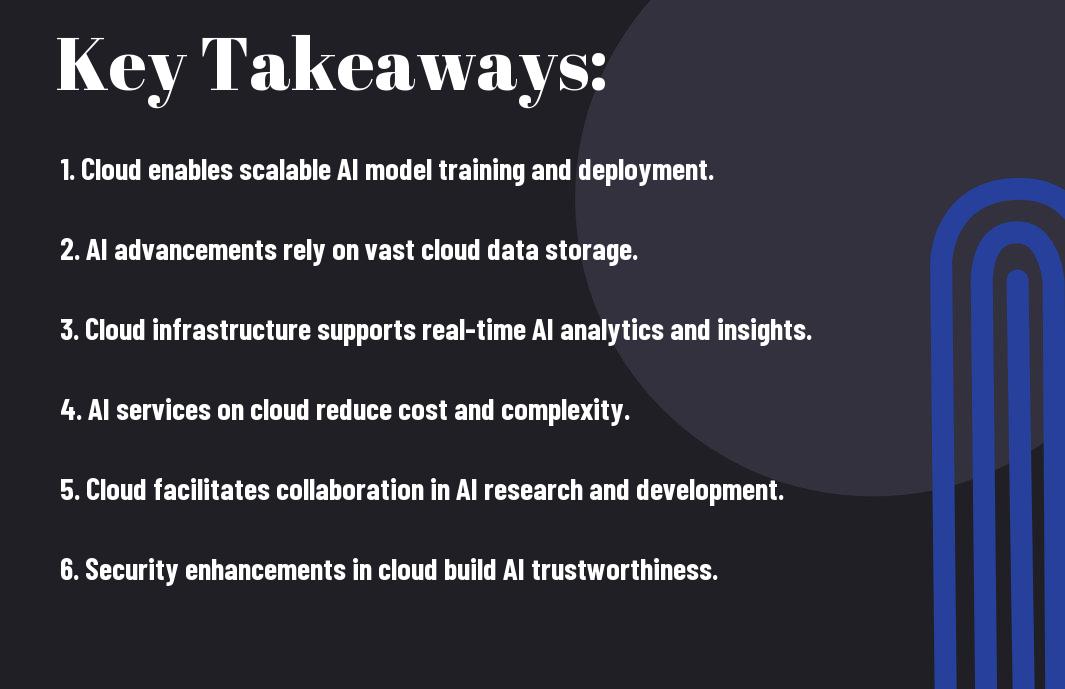Over the next decade, you will witness an unprecedented evolution in artificial intelligence that will dramatically impact various sectors. Integral to this transformation is cloud computing, which provides the necessary infrastructure to handle vast amounts of data and complex algorithms. With the synergy between AI and cloud technology, you can expect not only enhanced performance and scalability but also new opportunities for innovation. However, be aware of the potential risks associated with data security and ethical considerations as you navigate this rapidly changing landscape.
The Interplay Between AI and Cloud Infrastructure
The collaboration between AI and cloud infrastructure creates a seamless environment for enhancing computational capabilities, storage solutions, and data management. Cloud platforms enable AI applications to process enormous datasets without the constraints of on-premises hardware. As you leverage cloud services, you establish a dynamic framework that allows for speedy model training, instant updates, and continuous deployment, directly impacting AI performance and efficiency.
Decentralized Resource Utilization
Decentralized resource utilization democratizes AI development, allowing multiple users to access computing power without significant upfront investments. This model not only optimizes resource distribution but also reduces environmental impact by minimizing energy consumption across various data centers. By leveraging cloud capabilities, you gain the flexibility to tap into these resources as needed, ensuring that your AI projects can scale without interruption.
Scalability and Flexibility in AI Development
Scalability and flexibility are at the core of successful AI initiatives. In cloud computing, you can adjust resources based on the specific needs of your AI workloads, whether you are deploying a small prototype or a large-scale production model. For instance, platforms like AWS and Google Cloud allow you to utilize auto-scaling features, enabling you to expand your computing resources during peak demand, then scale back when not needed, ensuring cost-effectiveness and optimal performance.
This capability means that as your AI models require more data or computational power, you’re never limited by physical hardware constraints. You can experiment with different models and algorithms in real-time, adjusting parameters and configurations on the fly. In addition, having access to vast datasets stored in the cloud helps you train machine learning models more effectively, reducing time-to-market for AI solutions. Consequently, this remarkable scalability and flexibility empower you to innovate faster, refine applications continuously, and stay ahead of competitors in the rapidly evolving AI landscape.

Data Sovereignty: AI’s Dependency on Cloud Solutions
AI development increasingly relies on cloud computing, which provides the computational power needed for processing vast amounts of data. You must recognize that data sovereignty issues arise when leveraging cloud solutions, as regulations vary by country. Balancing the needs of AI innovation with compliance becomes important. Address this challenge by staying informed about laws that could impact how data is stored and processed. For a deeper understanding of the intersection between AI and cloud computing, check out The Future of AI & Cloud Computing.
Navigating Regulatory Compliance in Data Storage
Regulatory frameworks for data storage are evolving. Keeping abreast of requirements such as GDPR or CCPA influences how you manage data for AI models. Non-compliance could lead to hefty fines and reputational damage, so collaborating with legal experts and utilizing cloud services that ensure compliance is key.
The Role of Cloud Providers in Maintaining Data Privacy
Cloud providers play a pivotal role in ensuring your data privacy. These platforms implement rigorous security measures, such as encryption and multi-factor authentication, to safeguard your data. By leveraging their expertise, you can ensure that the data used in AI development is not only secure but also compliant with the applicable laws governing data privacy and sovereignty.
Cloud providers employ a variety of strategies to maintain data privacy, including advanced data encryption, routine audits, and compliance certifications. For example, major providers offer dedicated services tailored to specific regulations, helping your organization focus on AI innovation while they handle the intricacies of maintaining your data’s security. Additionally, many cloud solutions include detailed logging and monitoring capabilities, providing transparency and mitigating risks associated with data breaches. As you navigate the complexities of AI and cloud systems, ensuring you’re aligned with a reputable cloud provider can be a game-changer in maintaining your data’s integrity and privacy.
Cost Efficiency and Accessibility: Democratizing AI Capabilities
With cloud computing, AI capabilities become more affordable and accessible, allowing businesses of all sizes to harness advanced technologies without incurring hefty infrastructure costs. This democratization creates opportunities for innovation and competition across industries. Learn more in Infrastructure of the Future: The Impact of AI and the Cloud.
Comparing Traditional Models with Cloud-Based AI Solutions
| Traditional Models | Cloud-Based AI Solutions |
|---|---|
| High initial hardware investment | Pay-as-you-go pricing |
| Limited scalability | Flexible scaling options |
| Long deployment times | Rapid deployment |
| Requires in-house expertise | User-friendly interfaces with support |
Case Studies on Startups Leveraging Cloud Computing
- Startup A: Achieved a 60% reduction in project costs by utilizing cloud services for their AI training models.
- Startup B: Scaled user engagement by 150% within six months of migrating to cloud-based AI solutions.
- Startup C: Reduced time to market by 70% through enhanced collaboration tools provided by cloud platforms.
Many startups are thriving by harnessing cloud computing to scale their AI efforts effectively. For instance, Startup A reduced costs by 60% by leveraging cloud services for AI training models, while Startup B saw a 150% increase in user engagement in just half a year. Overall, cloud-based AI not only accelerates innovation but also drives efficient teamwork and resource management.
The Acceleration of Innovation: Rapid Deployment in AI
The rise of cloud computing has propelled the rapid deployment of AI technologies, allowing your organization to innovate at an unprecedented pace. With scalable resources and flexible environments available at any time, you can accelerate the development cycle from conception to deployment. This shift enables you to respond to changing market conditions swiftly and to harness AI’s capabilities without the lengthy wait times associated with traditional infrastructure setups.
Continuous Integration and Continuous Delivery (CI/CD) Practices
Incorporating CI/CD practices allows your team to automate testing and deployment processes, thereby minimizing errors and improving efficiency. Each code update can be seamlessly integrated, enabling faster iterations and quicker delivery of AI models into production. This sophisticated approach ensures your AI systems are up-to-date and capable of meeting real-time needs, effectively allowing you to stay ahead of competitors.
Real-Time Collaboration and Global Development Teams
Utilizing cloud platforms empowers your development teams to collaborate in real-time, regardless of their geographic locations. This level of global collaboration not only fosters innovation but also leverages diverse expertise, accelerating AI development. You can tap into talent pools across different regions, allowing you to address complex challenges with varied perspectives and skills effectively.
With cloud-based tools, you can integrate communication platforms, version control systems, and shared workspaces that keep your teams connected. Virtual project management solutions help facilitate transparency and timely updates, ensuring everyone remains aligned with the project goals. As a result, your teams can iterate on AI projects rapidly, experiment with ideas, and scale development efforts more efficiently. This dynamic environment encourages innovative thinking and enables you to deliver cutting-edge AI solutions that meet your organization’s strategic objectives.

Future Trends: Emergent Technologies Shaping AI and Cloud Synergy
The future of AI is being reshaped by significant advancements in emergent technologies, particularly through the integration of cloud computing. By harnessing abilities provided through The Role of Cloud Computing in Shaping AI’s Future, developers can expect to see enhanced capabilities in AI models and platforms. Emerging trends, such as quantum computing and edge computing, are becoming vital components that will drive a closer alliance between these technologies.
Quantum Computing’s Potential Impact on AI Processing
Quantum computing stands to revolutionize AI processing by enabling calculations at an unprecedented scale. With its capacity for parallelism, quantum systems can analyze massive datasets rapidly, making complex problem-solving far more efficient than traditional computers. Deep learning models, for instance, could see significant improvements in training times, allowing you to leverage AI for real-time data analysis and insights that previously seemed unattainable.
The Rise of Edge Computing in AI Applications
As devices become increasingly interconnected, the rise of edge computing is transforming how AI applications function. By processing data closer to the source, you reduce latency, enhance efficiency, and significantly alleviate the burden on central servers. Industries such as healthcare and manufacturing are already utilizing edge AI for real-time decision-making, illustrating a shift towards more responsive and adaptable systems.
In a world where speed and accuracy are paramount, edge computing synergizes with AI to provide immediate insights directly from the data source. For example, in smart cities, sensors gather real-time data on traffic patterns, allowing AI systems to optimize traffic flow immediately, leading to reduced congestion and improved safety. This not only enhances user experience but also paves the way for innovative applications across various sectors, bringing AI capabilities closer to everyday life without relying heavily on central cloud resources. As you explore these advancements, consider the ways your organization might harness the power of edge computing alongside AI initiatives to create agile, data-driven solutions.
Final Words
As a reminder, the future of AI is intricately linked to cloud computing, which provides the necessary infrastructure for innovation and scalability. As you explore the potential of AI technologies, consider how leveraging cloud resources can enhance your capabilities, reduce costs, and drive efficiency. By embracing this synergy, you position yourself to stay ahead in the rapidly evolving digital landscape, enabling you to harness powerful AI solutions that can transform your operations and decision-making processes.







